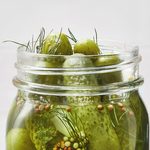Everything You Need To Know About The New Joy Of Cooking

Fully revised and updated, the latest edition of the iconic Joy of Cooking includes 600 new recipes—and the return of some long-lost classics.
Can a cookbook improve civilization? In this case, yes. Joy of Cooking has sold more than 20 million copies since Irma S. Rombauer, a St. Louis widower, self-published the first edition in 1931. It’s often called the bible of American cooking—though its influence and the range of recipes it contains reaches far beyond the U.S. The secret to its success is how Rombauer, unlike most cookbook authors of her time, wrote in a friendly, unintimidating manner, and gave advice that’d be useful to first-time and experienced cooks alike. It didn’t hurt that the book included fail-proof recipes for cherry pie, holiday turkey and a stiff bloody Mary, among many others.
When a book is that popular, and that well-loved, any change to it can cause an uproar. For the 20 million people who own the book, it’s like a best friend. They usually fondly refer to it as “The Joy.”
Now there’s a new edition, only the 9th time the cookbook has been updated. This one is the biggest yet, with more than 4,000 recipes. Here’s what you need to know about the new Joy.
What’s changed?
Nearly everything. The authors have added more than 600 new recipes and they’ve also retested and revised everything else. With each new edition of Joy, their aim has been to ensure it remains relevant to today’s home cook—since tastes, and what we want to cook, seems to evolve faster with every passing decade. The newest additions include everything from appetizers like fritto misto to pastries like kouign amann to gluten-free breads to a detailed section on how to prepare trendy spice blends like dukkah, sichuan pepper salt and za’atar. Even the instructional illustrations have been updated (now 3D representations rather than the much simpler line drawings of before).
What hasn’t changed?
The recipes are still written in the style—an innovation of Rombauer’s—that’s known as the “action method”: instructions are written out like a story, with a beginning, middle and end, and ingredients are listed at the point you need them, instead of at the top of the page. And those classics are all still here, including that cherry pie. That said, the new recipe begins with the more contemporary disclaimer “This cherry pie is so good it’ll kill ya,” some of the measurements have been tinkered with (part of the process of refining and re-testing each recipe), and they notably omit the 1 to 2 drops of red food colouring recommended in earlier editions, which only seemed necessary if your aim was a lurid Twin Peaks-style diner pie.
Wait, wouldn’t Irma S. Rombauer be 142 years old by now? Who is updating this thing?
That’s right—she published the first edition when she was 52, and passed away in 1962. But the book stayed in the family, with subsequent editions revised by her daughter, Marion Rombauer Becker, then by her grandson, Ethan Becker. This new edition was prepared by Ethan’s son John, and John’s wife Megan Scott.
Is it true they’ve revived the recipe for squirrel?
Yes! The instructions for small game (squirrel, raccoon, beaver and the like) disappeared in late 20th century updates, but lived on in urban legend, especially for a particularly graphic illustration in early editions of how to skin a squirrel (it involved holding down one limb with your foot). John Becker and Megan Scott have reintroduced the tips on how to prepare small game but left out the illustrations. (Can’t imagine eating squirrel in 2019? Check out these popular foods that people hated eating 100 years ago.)
Should I buy it?
Absolutely yes. The classic recipes are considered essential for a reason, and the new additions are soon-to-be-classics. This is the most multicultural of the Joys ever published, and you’ll find it very handy no matter what your ethnic background or culinary skills. For one, the recipe for Quebec-style tourtiere, redolent of clove and nutmeg, is first-rate. Order your copy of the new Joy of Cooking here.
Next, check out 50 cooking secrets chefs won’t tell you.



